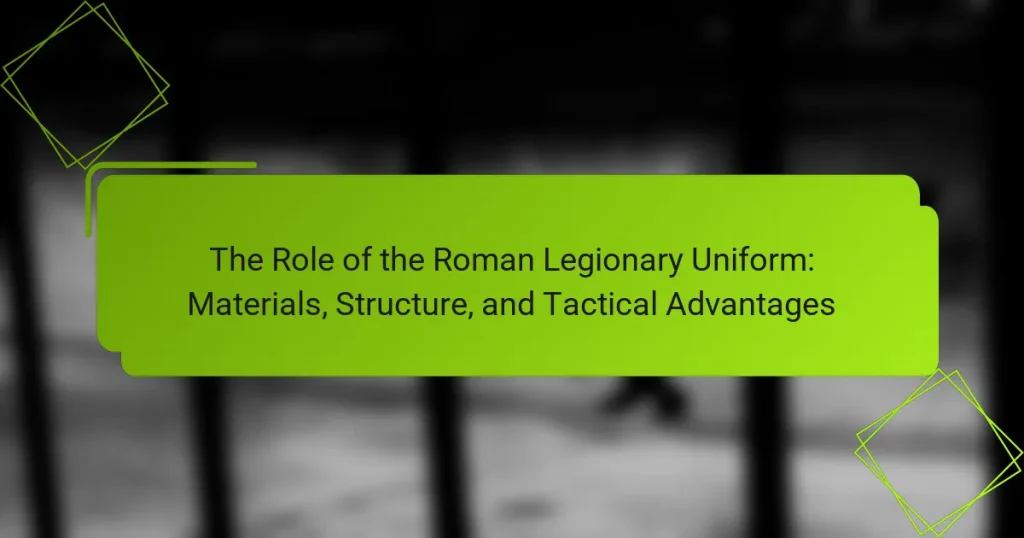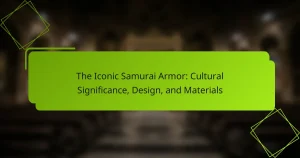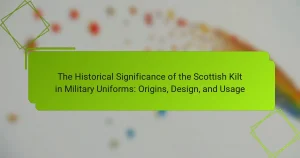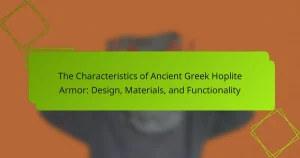The Roman Legionary Uniform is the standard military attire worn by Roman soldiers, known as legionaries, and includes key components such as a wool tunic, lorica segmentata armor, metal helmets, and specialized sandals. This uniform was designed to provide both protection and mobility, enhancing the tactical effectiveness of soldiers in battle. The layered armor offered defense against various attacks while promoting endurance during campaigns. Additionally, the uniform’s standardized appearance fostered discipline and unit cohesion among legionaries. The legacy of the Roman Legionary Uniform continues to influence modern military attire and is a subject of study in historical and cultural contexts.

What is the Roman Legionary Uniform?
The Roman Legionary Uniform is the standard military attire worn by Roman soldiers known as legionaries. This uniform typically included a tunic, armor, and protective gear. The tunic was usually made of wool and reached the knees. Armor included a breastplate called a lorica segmentata. Legionaries also wore a helmet, often made of metal, for head protection. The uniform was completed with sandals designed for marching. The design of the uniform provided both protection and mobility. Historical records show that this uniform evolved over time, adapting to combat needs.
How did the Roman Legionary Uniform evolve over time?
The Roman Legionary Uniform evolved significantly from the early Republic to the late Empire. Initially, the uniform consisted of a simple tunic and a cloak. By the 1st century BCE, soldiers wore a more standardized tunic, often accompanied by a belt. This period also saw the introduction of the lorica hamata, a chainmail armor that provided better protection.
In the 1st century CE, the lorica segmentata emerged, featuring metal plates that offered enhanced defense and flexibility. The helmet design also progressed, becoming more elaborate with features like cheek guards and neck protection. By the 2nd century CE, the uniform incorporated additional elements like greaves and improved footwear.
Throughout the Empire, regional variations appeared due to local materials and climate. The uniform’s evolution reflected changes in military tactics and technology. The adaptations made the Roman legions more effective in various combat situations, demonstrating the uniform’s role in their success.
What were the primary materials used in the construction of the uniform?
The primary materials used in the construction of the Roman legionary uniform were wool, linen, and leather. Wool served as the main fabric for tunics and cloaks, providing warmth and durability. Linen was often used for undergarments, offering breathability. Leather was essential for armor components, such as sandals and belts, ensuring protection and support. Metal elements, like bronze or iron, were also utilized in the creation of helmets and shields. These materials collectively contributed to the functionality and effectiveness of the uniform in battle.
How did the design of the uniform reflect Roman military values?
The design of the Roman military uniform reflected values such as discipline, unity, and functionality. The uniform was standardized, promoting a sense of belonging among soldiers. This standardization ensured that each legionary was easily identifiable as part of the Roman army. The materials used, like wool and leather, provided durability and protection, emphasizing the importance of readiness in battle. The uniform’s practical features, such as the tunic and armor, were designed for mobility and efficiency, showcasing the value placed on tactical advantage. Additionally, the uniform’s embellishments, like insignia and decorations, represented rank and achievements, reinforcing the value of honor and merit within the military hierarchy. Overall, the uniform’s design was a direct reflection of the core values that defined the Roman military ethos.
What are the key components of the Roman Legionary Uniform?
The key components of the Roman Legionary uniform include the lorica segmentata, galea, tunica, and caligae. The lorica segmentata is a segmented armor that provided protection and flexibility. The galea is a helmet designed to shield the head while allowing visibility. The tunica is a simple garment worn underneath the armor for comfort. The caligae are sturdy sandals that offered support during long marches. Each component was essential for the effectiveness and mobility of the legionary in battle. Historical records indicate that these elements were standardized to ensure uniformity across the legions. The uniform not only served practical purposes but also symbolized Roman military discipline and organization.
What role did the tunic play in the uniform’s functionality?
The tunic served as a fundamental component of the Roman legionary uniform. It provided essential coverage and protection for soldiers during combat. The tunic’s design allowed for ease of movement, which was crucial in battle scenarios. Typically made from wool, it offered durability and comfort in various weather conditions. The tunic’s length varied, often reaching the knees, which helped shield the legs. Additionally, it could be layered with armor for added protection. Historical evidence shows that the tunic was standardized, promoting uniformity among troops. This consistency reinforced unit cohesion and identification in the field.
How did armor contribute to the protection of legionaries?
Armor significantly contributed to the protection of legionaries by providing a barrier against weapons. The primary components included the lorica segmentata, a type of metal armor, and helmets that shielded vital areas. The segmented design of the lorica allowed for flexibility while maintaining strength. This armor could absorb and deflect blows from swords and projectiles. Additionally, it covered the torso, shoulders, and limbs, reducing the risk of injury. Historical records indicate that legionaries equipped with armor had a higher survival rate in battle. The use of armor also fostered a sense of discipline and unity among troops. Overall, armor was essential for enhancing the combat effectiveness and safety of Roman legionaries.
What accessories complemented the Roman Legionary Uniform?
The accessories that complemented the Roman Legionary Uniform included a belt, a cloak, and various protective gear. The belt, known as the cingulum, was worn to support the weight of the soldier’s equipment. The cloak, or sagum, provided protection against the elements and was practical for mobility. Legionaries also wore a helmet for head protection, which was often adorned with decorative crests. Additionally, they carried a scutum, a large rectangular shield that was crucial for defense. Other accessories included a gladius, or short sword, and a pilum, a throwing spear. These items collectively enhanced the functionality and effectiveness of the Roman Legionary in battle.

What tactical advantages did the Roman Legionary Uniform provide?
The Roman Legionary Uniform provided significant tactical advantages in battle. Its design facilitated mobility and protection for soldiers. The layered armor, including the lorica segmentata, offered defense against slashing and piercing attacks. The uniform’s weight distribution allowed for better endurance during long campaigns. Additionally, the standardized appearance of the uniform fostered unit cohesion and discipline among soldiers. The use of a short sword, or gladius, complemented the uniform’s design for close combat. The helmet provided head protection while maintaining visibility and hearing. Overall, the uniform enhanced the effectiveness of the Roman legions in various combat scenarios.
How did the uniform enhance mobility and combat effectiveness?
The Roman legionary uniform enhanced mobility and combat effectiveness through its design and materials. The tunic allowed for ease of movement, enabling soldiers to maneuver quickly in battle. The lightweight armor, made from materials like leather and metal, provided protection without hindering agility. The sandals featured flexible soles, which improved traction and speed on various terrains. Additionally, the uniform’s streamlined structure minimized bulk, allowing for rapid movements during combat. Historical evidence shows that these design features contributed to the legionaries’ tactical advantage in engagements. The combination of mobility and protection was crucial for the success of Roman military operations.
What design features facilitated movement in battle?
The design features that facilitated movement in battle for Roman legionaries included lightweight materials and modular components. The tunic was made from breathable fabrics, allowing ease of movement. The segmented armor, known as lorica segmentata, provided flexibility while protecting vital areas. The design of the shield, curved and lightweight, allowed for quick repositioning during combat. Additionally, the sandals featured a flexible sole, enhancing mobility across various terrains. These elements combined to ensure that legionaries could maneuver effectively in battle. Historical accounts show that these design choices contributed to the Roman army’s tactical advantages in various military engagements.
How did the uniform’s weight distribution impact a legionary’s performance?
The uniform’s weight distribution significantly impacted a legionary’s performance by enhancing mobility and reducing fatigue. Properly distributed weight allowed legionaries to maneuver effectively in battle. It facilitated quick movements and agility, essential for engaging in combat. The armor and gear were designed to balance the weight across the body. This design minimized strain on specific muscle groups. Historical evidence shows that a well-balanced uniform improved endurance during long marches. Consequently, legionaries could maintain their combat effectiveness over extended periods. This weight distribution was crucial for the overall success of Roman military tactics.
In what ways did the uniform symbolize Roman discipline and organization?
The Roman uniform symbolized discipline and organization through its standardized design and functionality. Each soldier wore a uniform that was consistent in color and style, promoting unit cohesion. This uniformity reflected the military’s hierarchical structure and emphasized loyalty to Rome. The materials used, such as wool and leather, were practical for combat and indicated the importance of readiness. Additionally, the uniform included insignia and decorations that represented rank and achievements. This visual representation of status reinforced the chain of command. The discipline of the Roman soldiers was evident in their adherence to uniform regulations, which maintained order within the ranks. Overall, the uniform served as a powerful symbol of the Roman military’s discipline and organizational prowess.
How did the uniform’s appearance affect troop morale?
The uniform’s appearance significantly influenced troop morale by fostering a sense of unity and pride among soldiers. When Roman legionaries wore their uniforms, they felt a strong connection to their comrades and the Roman Empire. The distinctive design and colors of the uniform symbolized their identity and purpose. This visual cohesion boosted confidence during battles and military campaigns. Historical records indicate that well-dressed troops were often perceived as more formidable by both allies and enemies. Consequently, the uniform’s appearance not only enhanced internal morale but also served to intimidate opponents.
What role did uniformity play in the effectiveness of the Roman military?
Uniformity significantly enhanced the effectiveness of the Roman military. It ensured cohesion among soldiers during formations and battles. Uniform attire allowed for quick identification of ranks and units. This visual consistency fostered discipline and morale among troops. The standardized equipment, including shields and armor, facilitated synchronized movements in combat. Historical accounts indicate that uniformity contributed to the success of the Roman legions in numerous campaigns. For example, during the Battle of Cannae, the organized ranks of uniformed soldiers demonstrated tactical superiority. Overall, uniformity in the Roman military was crucial for operational efficiency and battlefield success.

How can we analyze the legacy of the Roman Legionary Uniform today?
The legacy of the Roman Legionary Uniform can be analyzed through its historical significance and modern interpretations. The uniform represented the discipline and organization of the Roman military. It was designed for functionality, using materials like wool and leather. These materials provided durability and protection in battle.
Today, the uniform influences modern military attire and historical reenactments. The design principles of the Roman uniform are evident in contemporary tactical gear. Scholars study artifacts and historical texts to understand its impact. The uniform’s role in establishing Roman identity is also a focal point in cultural studies.
Overall, analyzing the legacy involves examining its practical applications and cultural ramifications in both historical and modern contexts.
What lessons can modern military uniforms learn from the Roman Legionary Uniform?
Modern military uniforms can learn several key lessons from the Roman Legionary Uniform. First, the importance of functionality is evident in the design of the Roman uniform. The Roman Legionary Uniform was designed for mobility and protection. It combined elements such as the lorica segmentata, which provided excellent defense while allowing for flexibility.
Additionally, the use of layered clothing helped regulate temperature and adapt to various climates. This adaptability is crucial for modern uniforms deployed in diverse environments. The Roman approach to uniformity also promoted unit cohesion and identity. Matching uniforms fostered a sense of belonging and discipline among soldiers.
Moreover, the emphasis on durability in materials used for the Roman uniform is relevant. Heavy-duty fabrics and armor ensured longevity in combat situations. Today’s military uniforms can benefit from similar material choices that enhance durability while remaining lightweight.
Lastly, the Roman Legionary Uniform incorporated practical accessories, such as the gladius and scutum, which were integral to a soldier’s effectiveness. Modern designs can similarly integrate functional gear that complements the uniform. These lessons highlight the enduring relevance of the Roman Legionary Uniform in informing contemporary military attire.
How do contemporary military designs reflect historical influences?
Contemporary military designs reflect historical influences through the incorporation of proven strategies and materials. Modern uniforms often draw inspiration from the Roman legionary uniform, which emphasized functionality and protection. The use of layered fabrics in today’s designs mirrors the protective qualities of the Roman armor. Additionally, the tactical advantages of historical formations are evident in modern military strategies. For instance, the emphasis on mobility and adaptability in contemporary forces can be traced back to the flexible formations used by Roman legions. Historical designs also influence camouflage patterns, which evolved from the need for concealment in various terrains. Overall, contemporary military designs maintain a dialogue with their historical predecessors, ensuring that lessons learned from the past inform current practices.
What practical insights can be drawn from the study of the Roman Legionary Uniform?
The study of the Roman Legionary Uniform reveals insights into military efficiency and adaptability. The uniform was designed for protection and mobility. It featured materials like wool and leather, which provided comfort and durability. The armor, such as the lorica segmentata, offered vital defense against weaponry. The uniform’s design facilitated quick movement in battle formations. Historical records indicate that soldiers were trained to wear and maintain their uniforms effectively. This ensured readiness in various combat scenarios. The uniform also served as a symbol of Roman identity and discipline. Overall, the Roman Legionary Uniform illustrates the importance of practical design in military success.
How can historical uniforms inform modern tactical gear development?
Historical uniforms serve as a foundational reference for modern tactical gear development. They provide insights into materials that balance durability and mobility. For example, Roman legionary uniforms utilized layered fabrics for protection and flexibility. This principle can be applied to contemporary tactical gear, enhancing performance in various environments.
Additionally, historical designs reflect functional aspects such as ease of movement and strategic layering. The Roman tunic allowed for agility in combat, informing modern designs that prioritize user mobility. Historical uniforms also emphasize the importance of adaptability to different climates. The use of breathable materials in ancient uniforms can inspire modern gear suitable for diverse weather conditions.
Overall, studying historical uniforms reveals essential design principles that enhance the effectiveness of modern tactical gear.
The Roman Legionary Uniform is the standard military attire worn by Roman soldiers, characterized by its tunic, armor, and protective gear. This article explores the evolution of the uniform from the early Republic to the late Empire, highlighting key components such as the lorica segmentata and galea, as well as materials like wool, linen, and leather. It examines how the uniform’s design reflects Roman military values, enhances mobility and combat effectiveness, and symbolizes discipline and organization. Additionally, the article analyzes the legacy of the uniform and its influence on modern military attire, drawing practical insights for contemporary tactical gear development.




